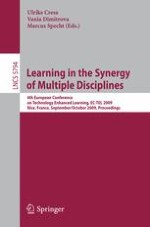This book constitutes the refereed proceedings of the 4th European Conference on Technology Enhanced Learning, EC-TEL 2009, held in Nice, France in September/October 2009. The 35 revised full papers, 17 short papers, and 35 posters presented were carefully reviewed and selected from 136 paper submissions and 22 poster submissions. The papers are organized in topical sections on adaptation and personalization, interoperability, semantic Web, Web 2.0., data mining and social networks, collaboration and social knowledge construction, learning communities and communities of practice, learning contexts, problem and project-based learning, inquiry, learning, learning design, motivation, engagement, learning games, and human factors and evaluation.
